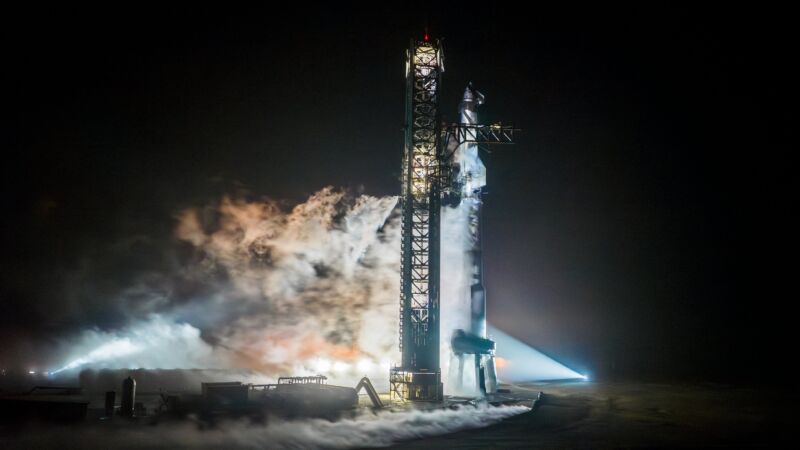
Enlarge / SpaceX’s Starship rocket completes a fueling test on Sunday night.
SpaceX
After SpaceX completed a fueling test of its third full Starship stack on Sunday night, successfully loading more than 10 million pounds of methane and liquid oxygen propellant onto the rocket, it was only a matter of time before the world’s largest rocket took flight.
Now, we have a tentative date. In a post on the social media site X, the company posted a link to watch “Starship’s third flight test” at 7: 30 am ET (11: 30 UTC) on March 14. Published on Tuesday morning, the social media post was ‘hidden,’ but somehow discovered late Tuesday night.
Nevertheless, this is a credible date that the company is working toward. Following the fueling test on Sunday night at the company’s Starbase site in South Texas, the hardware appears to be in good shape. Although SpaceX has yet to receive its launch license from the Federal Aviation Administration, the agency recently announced that it has closed its investigation into the second Starship test flight in November. So a mid-March launch date is plausible from a regulatory standpoint.
The first two Starship flights in April and November last year ultimately failed, but each of the experimental launches provided valuable data. On the second mission four months ago, the first-stage Super Heavy booster performed a nominal flight before it separated from the Starship upper stage. The Starship vehicle exploded a few minutes into its flight due to a leak during a liquid oxygen vent.
Based upon learnings from these first two flights, this next mission, with upgraded hardware and flight software, likely has a reasonable chance of success. Among the milestones SpaceX will seek to complete during this test flight are:
- Nominal first-stage performance, followed by a controlled descent of the Super Heavy booster into the Gulf of Mexico
- Starship separation from the first stage using “hot staging,” meaning engine ignition while the first stage is still firing its engines
- Starship reaching an orbital velocity and engine shutdown
- Early-stage testing of in-space refueling technology inside the propellant tanks of Starship
- Controlled splashdown of Starship near the Hawaiian islands after flying around two-thirds of the planet.
SpaceX is seeking to demonstrate the basic flight capabilities of Starship so that it can move into a more operational phase with the big rocket. The company wants to begin deploying larger Starlink satellites from the vehicle this year, which will enable direct-to-cell phone Internet connectivity.
Additionally, a higher cadence of missions will allow the company to begin developing the technology and procedures needed for the in-space storage and transfer of propellant for deep-space missions. This is a necessary step for SpaceX to fulfill its obligations to NASA for the Artemis program, which seeks to return humans to the Moon later this decade.
In a recent update, the company said more Starships are ready for flight, so a higher cadence is possible if this month’s flight is a success. Recently, the Federal Aviation Administration disclosed that SpaceX is seeking to launch Starship at least nine times this year.